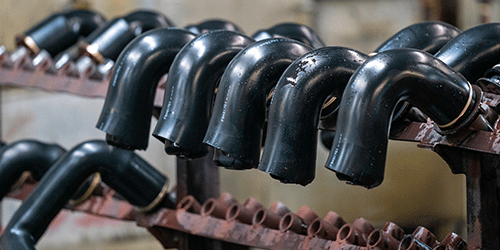Last month we took a closer look at the mandrel and how Sperry & Rice uses it for their mandrel formed hoses. This month we are digging a little deeper and bringing you behind the scenes to our production floor.
Here we can see a single mandrel up close. As discussed last month, tubes or hoses are placed on the mandrel so that they retain the shape throughout the curing process. At Sperry & Rice, they are rarely used singularly.
More often, many mandrels are on a rack, like the one shown to the right. A mandrel rack holds several pieces of material at once, such as these black rubber hoses.
Behind the rack we can see a large round door, which is the opening to an Auto Clav. The mandrel rack is on wheels, making it easy to load and roll into the Auto Clav.
The Auto Clav functions like a pressure cooker, rapidly “cooking” the hoses. After 15-20 minutes, the rack is rolled out and the hoses are removed, having maintained the shape of the mandrels. This process is called “curing.”
Lastly, we will show another type of rack used for curing that is similar to the mandrel rack, but not quite the same. On the left is a close up of trays that are loaded with materials – like the gaskets shown here – and rolled into the Auto Clav to be cured. The difference is that these materials do not need internal support, so they are not considered “mandrel formed.”
There are a lot of nuances when it comes to shaping rubber and plastic components, but you don’t have to be an expert. At Sperry & Rice, we know the ins and outs of forming, curing, and producing the best extruded parts for your needs. We’re the experts, so that you don’t have to be. Click or call today to see what we can do for you.
